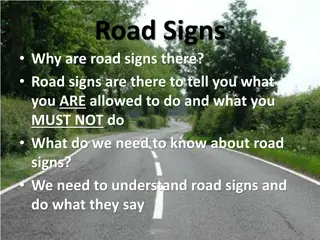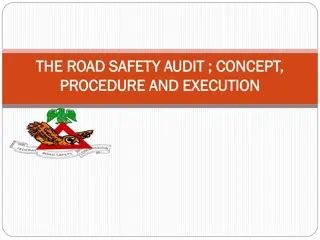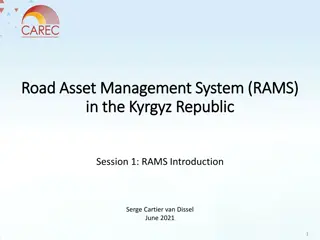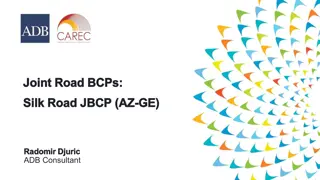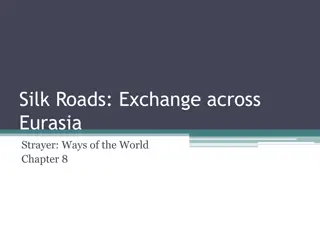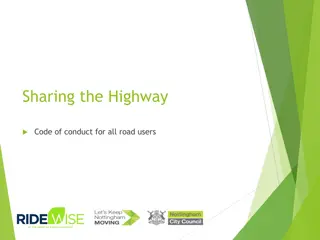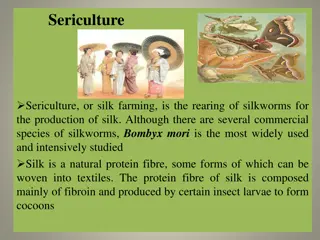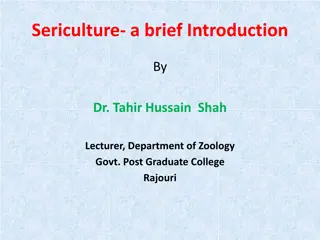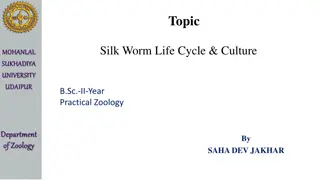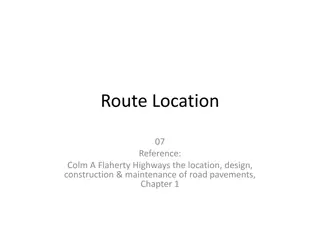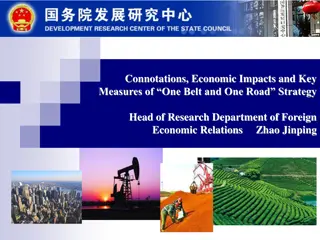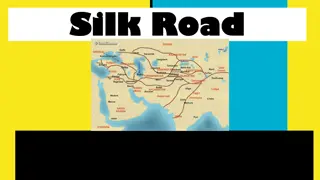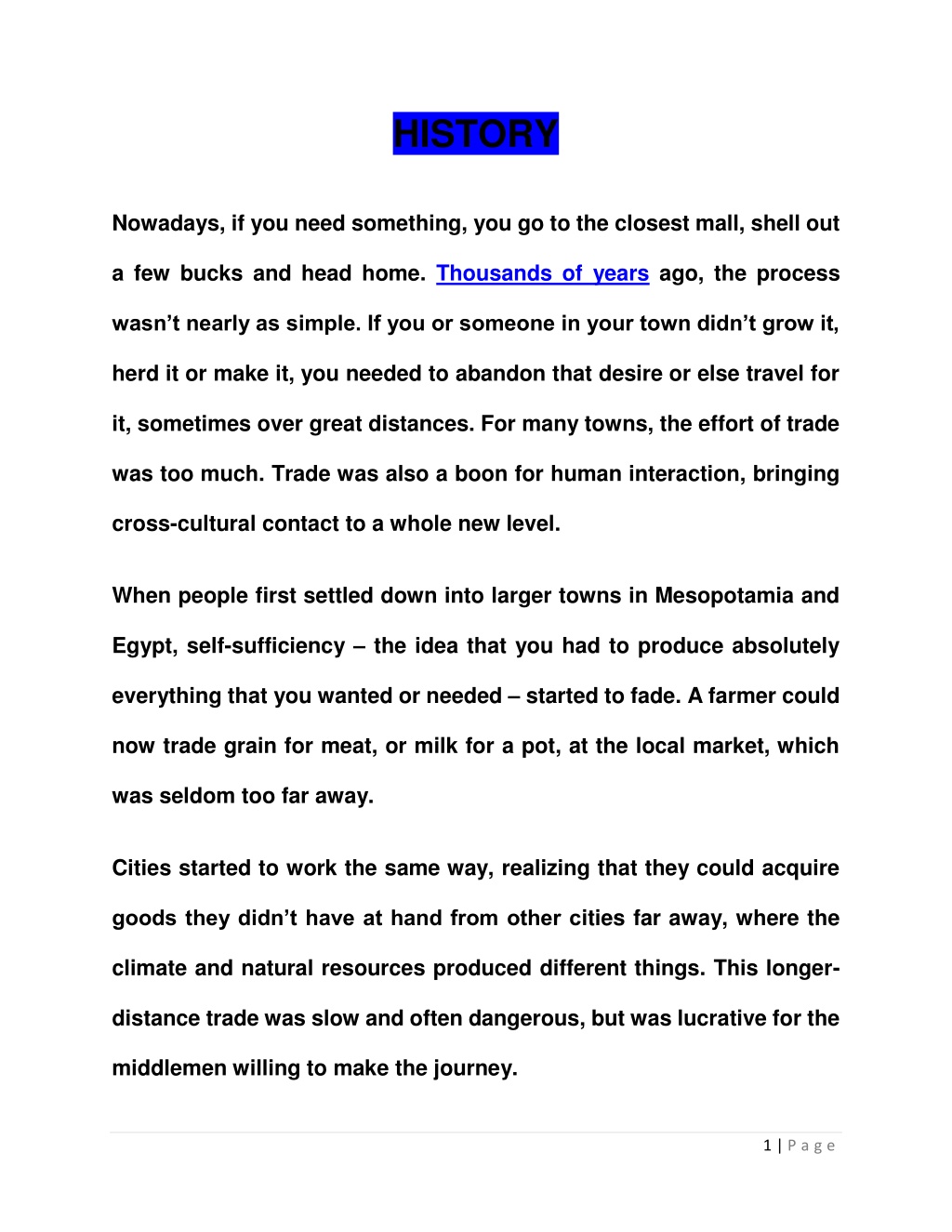
Silk Road
//seribangash.com/nSilk Road is a term introduced in 1877 by German geographer Ferdinand von Richtofen to describe the trade routes between the Mediterranean basin and the Far East. Silk was one of the main commodities exchanged along these route
Download Presentation

Please find below an Image/Link to download the presentation.
The content on the website is provided AS IS for your information and personal use only. It may not be sold, licensed, or shared on other websites without obtaining consent from the author. Download presentation by click this link. If you encounter any issues during the download, it is possible that the publisher has removed the file from their server.
E N D
Presentation Transcript
HISTORY Nowadays, if you need something, you go to the closest mall, shell out a few bucks and head home. Thousands of years ago, the process wasn t nearly as simple. If you or someone in your town didn t grow it, herd it or make it, you needed to abandon that desire or else travel for it, sometimes over great distances. For many towns, the effort of trade was too much. Trade was also a boon for human interaction, bringing cross-cultural contact to a whole new level. When people first settled down into larger towns in Mesopotamia and Egypt, self-sufficiency the idea that you had to produce absolutely everything that you wanted or needed started to fade. A farmer could now trade grain for meat, or milk for a pot, at the local market, which was seldom too far away. Cities started to work the same way, realizing that they could acquire goods they didn t have at hand from other cities far away, where the climate and natural resources produced different things. This longer- distance trade was slow and often dangerous, but was lucrative for the middlemen willing to make the journey. 1 | P a g e
The first long-distance trade occurred between Mesopotamia and the Indus Valley in Pakistan around 3000 BC, historians believe. Long- distance trade in these early times was limited almost exclusively to luxury goods like spices, textiles and precious metals. Cities that were rich in these commodities became financially rich. The domestication of camels around 1000 BC helped encourage trade routes over land, called caravans, and linked India with the Mediterranean. The trade routes served principally to transfer raw materials, foodstuffs, and luxury goods from areas with surpluses to others where they were in short supply. China, for example, supplied West Asia and the Mediterranean world with silk, while spices were obtained principally from South Asia. Throughout history, Eurasia was crisscrossed with communication routes and paths of trade, which gradually linked up to form what are known today as the Silk Roads; routes across both land and sea, along which silk and many other goods were exchanged between people from across the world. The silk and Spice routes become the main arteries of contact between the East and the West. 2 | P a g e
The spices and the silk land routes have been vanished with the introduction of Maritime routes in 1500 BC. But in September 2013, in a speech at Kazakhstan s Nazarbayev University, Chinese President Xi Jinping announced the so-called Silk Road Economic Belt, along the old Silk Road, a new foreign-policy initiative aimed at boosting international cooperation and joint development throughout Eurasia. He also showed the determination for the revival of old silk road from East to West. INTRODUCTION OF SILK ROAD Silk Road is a term introduced in 1877 by German geographer Ferdinand von Richtofen to describe the trade routes between the Mediterranean basin and the Far East. Silk was one of the main commodities exchanged along these routes, but not the only one; spices, dye, furs came to the west through them. Manufactured goods small metal objects and glass wares were shipped eastwards and the imbalance was covered with payments in gold. 3 | P a g e
HISTORY OF SILK ROUTE Despite the great distance between East Asia and the Mediterranean, the two regions had contact prior to the beginning of the Common Era pilgrims and warriors traveled along the Silk Road from Rome and Syria in the west to as far as China in the East. 4 | P a g e
To understand the history of the Silk Road, one must understand the major empires of the Silk Road. The Silk Road enjoyed three Golden Eras:- The second century BCE to the second century CE The seventh century to tenth century CE The twelfth to fourteenth century 5 | P a g e
SECOND CENTURY BCE TO SECOND CENTURY CE The first major large scale contact between East and West came with the conquest of Central Asia by Alexander the Great. By 323 BCE, Alexander s empire stretched from Greece in the west to Egypt in the south and through Iran to northern India. As Alexander the Great Empire s fell, new powers arose. At the same time, Zhang Qian, a Chinese general during Han Dynasty, became the first recorded Chinese to reach Central Asia. His reports enabled China to extend its influence far to the west, as far as in modern day Uzbekistan. Chinese control of this vast region established the trade routes for silk and other goods, thus marking the beginning of the Silk Road as active trade route. Silk first reached Rome in the first century BCE. SEVENTH CENTURY TO TENTH CENTURY In the seventh century, China was again united and powerful under the Tang Dynasty, and Islam began to dominate Central Asia. This new religion quickly spread throughout the east and Central Asia. The 6 | P a g e
conquests of the Arab provide the safety brought to the merchants traveled freely throughout these regions. Meanwhile, the Tang Dynasty in China opened itself up to ideas and goods imported from abroad. Xuan Zang, a Buddhist monk, traveled from China to India and back again. The Tang Dynasty gradually lost influence and problems were created for the merchants. The Arabic merchants started relying on sea route to bring their goods to China opening up sea trade routes between territories along the Silk Road. TWELFTH CENTURY TO FOURTEENTH CENTURY From 1206 to 1227, Genghis Khan, the leader of the Mongols conquered most of the Eurasian land mass from China to the Mediterranean. His grandson, Kublai Khan conquered and united China in 1279, bringing the entire Silk Road under Mongol Control. During Kublai Khan Reign as emperor, many Europeans visited China, including Marco Polo. At almost the same time, Rabban bar Suama, a Nestorian Christian who was born in Beijing, reached Paris and Rome going from east to. 7 | P a g e
DECLINE OF THE SILK ROAD The Mongol Empire fell apart in the fourteenth century. Portuguese sailor Vasco da Gama became first European to travel from Europe to India by sea in a voyage. Once this sea route was established, it became the preferred method for conducting trade between Europe and South and East Asia. As the Portuguese, Dutch, French and English gained control of the seas and established colonies in Asia. Sea route thus became the preferred method of economic exchange for the European powers, and the land silk road routes were used less. In fact China s Ming Dynasty stopped trading silk abroad in the 1400s because silk was produced in Central Asia and Europe by this time. 8 | P a g e
GEOGRAPHY OF SILK ROUTE The Silk Road crosses Asia from China to Europe. It is not a single road, but a collection of related historical trade routes. They are multiple interlinked routes. Now here we will see the silk routes on land, sea and the route through Pakistan one by one. Overland routes The main caravan route from China to the West started in the capital Chang an, what we know today as the great city of Xi an, headed west to Lanzhou on the banks of the Yellow River, northwest along the Hexi Corridor to the Han dynasty garrison town of Dunhuang. Beyond Dunhuang the main route goes around the Taklimakan Desert to Uramqi, Hotan and then to Kashgar. Today, Kashgar is China s westernmost city. After Kashgar, the main route goes: northwest into Central Asia, along the Ferghana Valley in Kyrgyzstan, on toward Tashkent in Uzbekistan and onward Samarkand 9 | P a g e
and Bokhara, then southwest through Turkmenistan, often via Merv in Turkmenistan, and into Iran. Beyond Tehran, the route goes to Bhagdad onward to Damascus and from Damascus the route splits between the northern route through Aleppo, Constantinople, Antioch, Bursa, and then Venice. southern route through Cairo to Alexandria and There were related routes within China that goes from chang an towards North to Beijing and towards East to Hangzhou. Related routes The silk route enters Pakistan from Kashgar through Khanjrab Pass via Gilgit to Abottabad, Taxila and then towards Peshawar and enters into Afghanistan via Kabul and from Bactria the route again joins the silk route at Marve. The same route head towards Rawalpindi then towards Lahore and from Lahore the route splits into two routes one goes to Gwader and Karachi and second route enters into India and reaches New Delhi and onward to Bombay. The route further goes to Bangladesh and Myanmar that are not depicted in the slide. 10 | P a g e
Maritime Silk Road The maritime Silk Road has an obvious parallel to the land-based new Silk Road. MSR starts with Quanzhou and also hit Guangzhou, Beihai, and Haikou before heading south to the Malacca Strait. From Kuala Lumpur, the Maritime Silk Road heads to Rangoon and Chittagong in the Bay of Bengal, then head towards Kolkata India, Colombo in Sri Lanka and from Colombo the route splits into northern route and southwest route. The northern route heads towards Bombay in North of India, Karachi and Gwader in Pakistan, Basra in Iraq, Muscat in Oman, Aden in Yemen and the south west route meet the northern route at Aden via D jibouti. The route further moves through the Rad Sea into Alexandria and further goes to the Mediterranean, with a stop in Athens before meeting the land-based Silk Road in Venice. 11 | P a g e
CONSTRUCTION COST OF SILK ROUTE Although it is very difficult to say about the cost of the revival of the silk route at this time, where there is not a clear picture yet about the route of the Silk Road. However, till that time, some estimates could be drawn. 12 | P a g e
The cost of the Silk Route is mind-blowingly big and exact cost would not be figured out. However, China, has planned to spend billions of dollars to revive intercontinental land routes and develop maritime links to expand commerce and give it more weight in a freight system dominated by European shipping lines. President Xi Jinping has announced an initial $40 billion for a Silk Road fund to invest in infrastructure and industrial and financial cooperation, aiming to break the connectivity bottleneck in Asia. China has also set up an Asian Infrastructure Investment Bank with authorized capital of 100 billion U.S dollars, to support the revival of the Silk Road. A total of 21 Asian countries willing to join the Asian Infrastructure Investment Bank. EFFECT ON TRADE Through the revival of Silk route, all the countries of Eurasia could get benefit, whether they are supplier, transit or consumer countries and also this route will be having significant effect on International trade. Some of them are described here:- 13 | P a g e
Energy Recent energy crises and price fluctuations have shown the importance of developing new hydrocarbon resources and distribution routes worldwide to meet growing demands and to ensure that a single disruption in the supply chain does not cripple a country or impede development. In this regard silk route will be helpful to give an opportunity to Kazakhstan to bring his oil reserves into International Markets and for Turkmenistan, a chance to transport its excessive gas reserves. De-value of Dollar Russia is decoupling its trade from the dollar, decoupling its hydrocarbon trade from the petro-dollar, and working with China to re- open the old Silk Road between China, Germany, and Russia. Russia s lead and decoupling their trade from the dollar, especially in hydrocarbons to local currencies and trading partner currencies, furthermore, China has been in the process of decoupling from the dollar for months. The dollar future could be seen downgrading in this context. 14 | P a g e
More Trading for Eurasian Countries The new economic Silk Road, which is going to use Duisburg, the world s largest inland harbor and link Russia and China through the world s fourth largest economy, as well as with Kazakhstan, Belarus, and Poland, has the potential to overshadow all of this from a trade perspective. But a new trading route, which can get things from China to Duisburg in 18 days or less, could significantly shift the global balance of trade, see less trading between the West and the East, and even increase trading on the Eurasian continents More Trading through Land Road instead of Sea Route It s hard to say what will happen, but chances are some ocean carriers will lose considerably, as more goods will be moving over land, and carriers servicing the ports along the New Silk Road will gain, as trade shifts to minimize the amount of time cargo needs to spend on the ocean as time is money. 15 | P a g e
IMPACT ON ECONOMY OF CONCERNED COUNTRIES The Silk Route initiatives will create trade and investment opportunities in infrastructure and construction, including transportation, ports, pipelines, power generation and environmental projects, as well as stimulating energy and resource exchanges, consumption and tourism for the concerned countries of Eurasia. Prosperity and People to People Contact All the countries along the silk route will get a major breakthrough in their socio-economic ties as well as having more and more people-to- people contact with the construction of new Silk Road. This will bring the countries of Eurasia more close to each other. The ancient Silk Road played a key role in cultural exchanges between Asia and Europe. The route will connect 18 countries with a population over 3 billion to each other. Market Potential and Geographic Advantages The countries are making the transition from being emerging economies to developed economies, and will thus benefit from 16 | P a g e
financing from China. The countries will enjoy relatively good investment conditions such as cheap and abundant labor. The CEE economies can help China access the EU market and EU technology more easily. Because of this, Chinese investment in the region has increased in recent years with multi-tiered cooperation and exchanges taking shape. Less Dependency on World Bank Chinese diplomats have also been busy promoting a new Asian Infrastructure Investment Bank, promising to provide half of its $50 billion start-up capital, to help build ports, roads, power projects and other desperately needed infrastructure across the region. The Silk Road fund and Asia Infrastructure Investment Bank pose a direct challenge International Monetary Fund, World Bank. Tourism Nineteen Chinese and foreign cities along the Silk Road will jointly develop tourism along the ancient trade route. The cities will promote tourist itineraries and explore tourism resources to rejuvenate the area and seek mutual benefit. China will cooperate with countries along the 17 | P a g e
Silk Road to issue more tourist-friendly policies, set up promotion platforms and boost interconnection along the route. Help Reduce Terrorism It the same time, economic development could help to shake off poverty, which may have contributed to breed terrorism, Plans are shaping up for more financing into terrorist hit countries to uplift the living conditions of the citizens. Same China wants to uplift Xingjian to end terrorist in the region. A number of factories will be established along the regions of the terrorists to provide employment so that terrorists could come back to their normal life. IMPACT ON PAKISTAN For centuries, the southern part of the land Silk Roads has found its way through modern Pakistan and then curved east into India or continued south to the Arabian Sea. In addition to the effects described above, he silk route have some exclusive effects on the economy of Pakistan in the following ways:- 18 | P a g e
Dreams to Come True The experts have said that the proposed economic corridor between China and Pakistan connect the dreams of the two countries. The China Dream refers to the great rejuvenation of the Chinese nation, while a similar dream in Pakistan is called making the country into an Asian tiger. The economic corridor project connecting Kashgar in China s Xinjiang Uygur autonomous region to the southwestern Pakistani port of Gwadar was proposed between the two countries. Construction of Road/Railway Infrastructure Pakistani authorities try to revive the old trade routes through the construction of the Karakoram Highway which joins the remote northern reaches of the country with the Chinese Region of Xinjiang the historical routes of trades. China is negotiating with Pakistan, Mongolia, Uzbekistan and Kyrgyzstan to build three connective railroads to revive the ancient Silk Route and improve regional trade on the economic belt. China has allocated funds to do preliminary research on building an international railway connecting the westernmost city of Kashgar in the 19 | P a g e
Xinjiang Uygur autonomous region with Pakistans deep-sea Gwadar Port. The 1,800-kilometer railway is planned to pass through Pakistan s capital of Islamabad and Karachi. Development The oil and gas pipelines between Gwadar Port and China are also on the agenda along silk route. This will make Pakistan to cope up with its ever increasing energy consumption from central Asian countries. The economic corridor will bring the economic stability in the country. Besides the corridor project, the cooperation in economy, science and technology as well as culture and education could be foreseen. Due to a number of mega projects, employment for the Pakistanis will be a great benefit. Cargo Facilities and Transportation Sectors will be able to get increased profits through opening of these routes and same as the new opening for the Pakistanis goods in the China and Central Asia as well as in Europe. 20 | P a g e
This will provide better opportunities for Pakistan to contact and having friendly relations with not only China but also to the Central Asian Countries. For More Interesting Blogs Please Visit : https://seribangash.com/silk-route-12-treasures-trade-culture/ https://seribangash.com/silk-road-magical-treasures-trade-and-business/ https://seribangash.com/dry-fruits-business-strategies-for-success-2024/ 21 | P a g e





